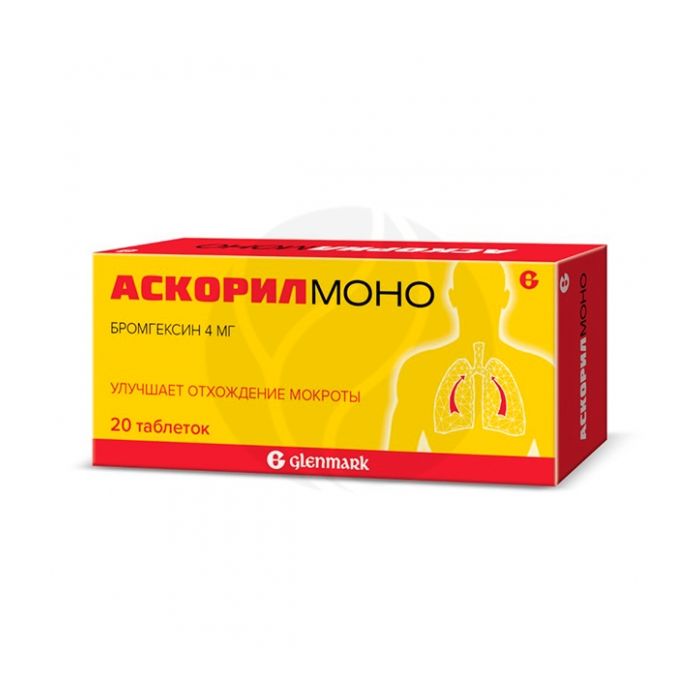Ascoril Mono tablets 4mg, No. 20
Expiration Date: 05/2027
Russian Pharmacy name:
Аскорил Моно таблетки 4мг, №20
Acute and chronic bronchopulmonary diseases, accompanied by difficulty in the discharge of viscous sputum:
tracheobronchitis,
bronchitis of various etiology (including complicated by bronchiectasis),
bronchial asthma,
pulmonary tuberculosis,
emphysema of the lungs,
pneumonia (acute and chronic),
pneumoconiosis,
cystic fibrosis.
Rehabilitation of the bronchial tree in the preoperative period and during medical and diagnostic intrabronchial manipulations, prevention of the accumulation of thick viscous sputum in the bronchi after surgery.
Inside, regardless of the meal.
Adults and children over 14 years old - 8-16 mg (2-4 tablets) 3-4 times a day.
Children from 6 to 14 years old - 8 mg (2 tablets) 3 times a day.
Children from 3 to 6 years old - 4 mg (1 tablet) 3 times a day.
The therapeutic effect may appear on the 4th-6th day of treatment. The course of treatment is from 4 to 28 days.
In case of impaired renal function or severe liver disease, the intervals between doses should be increased, or the dose should be reduced. On this issue, you need to consult with your doctor. During treatment, it is recommended to consume a sufficient amount of fluid to maintain the secretolytic effect of bromhexine.
It is not recommended to take bromhexine for more than 4-5 days without consulting a doctor.
If during the period of treatment with the drug there is no improvement or the symptoms worsen, or new symptoms appear, you should consult your doctor. Use the drug only according to the indications, the route of administration and the doses indicated in the instructions.
Composition for 1 tablet:
Active ingredient: bromhexine hydrochloride - 4.00 mg.
Excipients: lactose monohydrate (milk sugar) - 80.23 mg; corn starch - 11.54 mg; povidone K-25 - 3.46 mg; magnesium stearate - 0.77 mg.
Hypersensitivity to the components of the drug,
peptic ulcer and 12 duodenal ulcer,
pregnancy, breastfeeding period,
children under 3 years old,
hereditary lactose intolerance,
glucose-galactose malabsorption,
lactase deficiency.
Use with caution in patients with a history of gastric bleeding, with bronchial diseases accompanied by excessive accumulation of secretions, with a history of episodes of hemoptysis, renal and / or liver failure. Application during pregnancy and during breastfeeding Bromhexine penetrates the placental barrier, as well as into breast milk. The drug is contraindicated for use during pregnancy and during breastfeeding. If it is necessary to use the drug during lactation, breastfeeding should be discontinued for the duration of treatment.
Pharmacodynamics
Mucolytic (secretolytic) agent, has an expectorant and weak antitussive effect. Reduces the viscosity of sputum (depolymerizes mucoprotein and mucopolysaccharide fibers, increases the serous component of bronchial secretions); activates ciliated epithelium, increases volume and improves sputum discharge. Stimulates the production of endogenous surfactant, which ensures the stability of alveolar cells during respiration. The effect appears within 2-5 days from the start of treatment.
Pharmokinetics
When taken orally, bromhexine is almost completely (99%) absorbed into the gastrointestinal tract within 30 minutes. Bioavailability - low (effect of primary 'passing' through the liver). Bromhexine in plasma binds to proteins, crosses the blood-brain and placental barriers, and also into breast milk. In the liver, bromhexine undergoes demethylation and oxidation, and is metabolized to the pharmacologically active ambroxol. The half-life (T1 / 2) is 15 hours (due to slow reverse diffusion from tissues). It is excreted by the kidneys. In chronic renal failure, the excretion of bromhexine metabolites is impaired. With repeated use, bromhexine can accumulate.
Overdose
The following symptoms are possible: nausea, vomiting, diarrhea, and other gastrointestinal disturbances.
Treatment: there is no specific antidote. In case of an overdose, it is necessary to induce vomiting, and then give the patient a liquid (milk or water). Gastric lavage is recommended within 1-2 hours after taking the drug.
Side effects
From the gastrointestinal tract: abdominal pain, dyspepsia, incl. nausea, vomiting, exacerbation of gastric ulcer and 12 duodenal ulcer.
Allergic reactions: hypersensitivity reactions (skin rash, itching, angioedema, rhinitis), urticaria, fever, anaphylactic reactions, including anaphylactic shock.
Skin and subcutaneous tissue disorders: Stevens-Johnson syndrome, Lyell's syndrome, acute generalized exanthematous pustulosis.
Others: dizziness, headache, increased activity of 'liver' transaminases in the blood serum.
Special conditions
Very rarely, the occurrence of Stevens-Johnson and Lyell syndromes, which are temporarily associated with taking the drug Bromhexine, has been reported. If changes occur on the skin or mucous membrane, you must stop taking the drug and consult a doctor.
In the course of treatment, it is recommended to consume a sufficient amount of liquid, which supports the secretolytic effect of bromhexine.
In children, treatment should be combined with postural drainage or vibration massage of the chest, facilitating the evacuation of secretions from the bronchi.
Influence on the ability to drive vehicles and work with mechanisms
Reception of the recommended therapeutic doses (16 mg 3 times a day) does not affect the speed of the patient's psychomotor reactions. In case of development of side effects when using the drug, care should be taken when driving vehicles and mechanisms.
Drug interactions
Bromhexine is not prescribed concurrently with drugs that suppress the cough center (including those containing codeine), since this makes it difficult to pass liquefied sputum (accumulation of bronchial secretions in the airways).
Bromhexine promotes the penetration of antibiotics (amoxicillin, ampicillin, erythromycin, cephalexin, oxytetracycline), sulfa drugs into bronchial secretions in the first 4-5 days of antimicrobial therapy. The combined use of bromhexine with some non-steroidal anti-inflammatory drugs (salicylates, phenylbutazone or butadione) can irritate the gastric mucosa.

